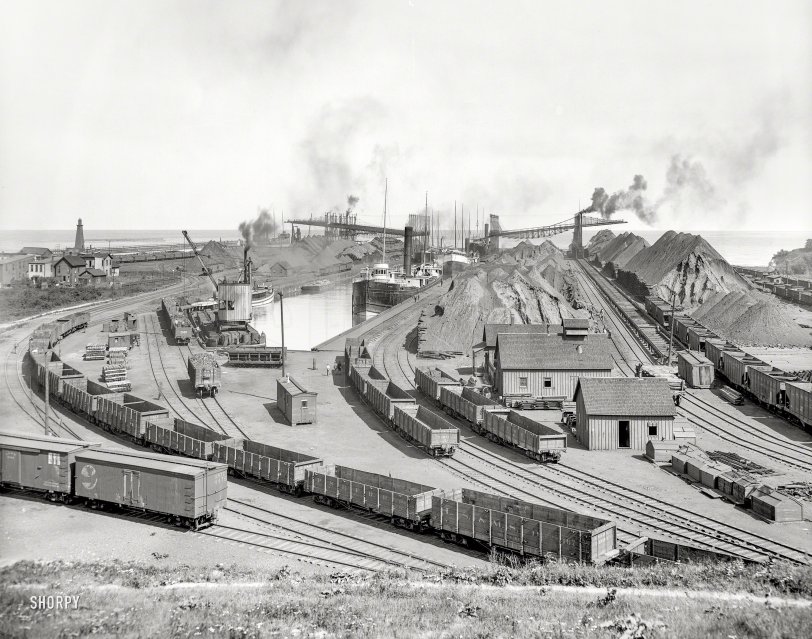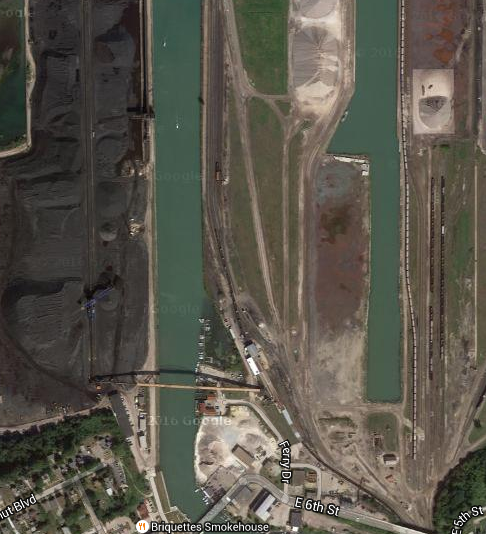


Framed or unframed, desk size to sofa size, printed by us in Arizona and Alabama since 2007. Explore now.
Shorpy is funded by you. Patreon contributors get an ad-free experience.
Learn more.

- Details, Details
- What's that building to the left of the tower?
- Coal Barges
- Bromo-Seltzer
- Inner harbor
- The Basin
- What a headache!
- Giant stepladder?
- Baldwin 62303
- Baldwin VO-1000
- Cold
- No expense spared
- Tough Guys
- Lost in Toyland
- And without gloves
- If I were a blindfolded time traveler
- Smoke Consumer Also Cooks
- Oh that stove!
- Possibly still there?
- What?!?
- $100 Reward
- Freeze Frame
- Texas Flyer wanted
- Just a Year Too Soon
- WWII -- Replacing men with women at the railroad crossing.
- Yes, Icing
- You kids drive me nuts!
- NOT An Easy Job
- I wonder
- Just add window boxes
Print Emporium
Iron Ore on Erie: 1900

Circa 1900. "Lake Shore & Michigan Southern Railway ore docks, Ashtabula, Ohio." 8x10 inch glass negative, Detroit Publishing Company. View full size.
Rebuilds...
The hopper cars on the far right look to be rebuilds from earlier composite hoppers. Composite types had metal frames, and wooden sides with metal bracing. These cars, however, look to be of an all metal construction. While not overly common in 1900, all metal construction hoppers were starting to come into use. The cars had a longer life span than the wooden composite types, and actually ended up being cheaper to operate in the grand scheme of things.
More "Cranes"
Those structures do not have conveyor belts - if you look closely, you can see a few of the buckets at various distances from the ship. There are small 'trolleys' which move along the bridge-like structures, one on each. Each trolley caries a bucket (probably clamshell) which can reach into the ship's hold, remove some ore (or coal, but I suspect ore), raise it up, and then move either over the large piles, or over railroad cars to dump the load.
Short-lived lighthouse
The lighthouse at the left side of the picture dates this to between 1897 and 1904, the latter date when these facilities were doubled in size and a whole new terminal was built for the Pennsy. It served as the rear light of pair to guide ships into the harbor. With the expansion a new tower was built in the new section, and that was all she wrote for this one.
D for dedicated
The Lake Shore & Michigan Southern gondolas have the letter D prefacing the car number. This told car checkers the car was in dedicated service so not to be taken off its current route. In this case mine to pier to steel mill over and over again.
The ore bridges were a step up from the whirley cranes but soon have competition from massive Hullet unloaders with their grasshopper-like dipping legs.
The ground looks clean since this was an area where only the most foolish non-railroader would tread and drop trash. There is little in this photo that a safety inspector would praise. Those crib retaining walls being a first concern.
Still there
The docks are still there, with ore trains and big piles of ore. Only the equipment has disappeared. I imagine that a modern loader can move a third of a carload in one scoop.

"Cranes"
I think those are actually movable sets of elevators/conveyor belts. They transfer the material (coal) from one side and then dump it into the piles you see. They move side-to-side (into and out of the page in this picture) to service different parts of the yard. I think there are elevators/bucket lifts on the input side that puts the material on the belts which climb then the stuff falls off the free end.
Cranes?
How did those Crane like thingies in the background work?
Clean, but ...
Am struck by how clean this busy site seems to be. Of course, those massive piles of iron ore are a rust-red color and that tint might prevail all across the scene. A really fine steel industry shot. Glad you put it up.
When You're Out of Schlitz ...
That little Schlitz private owner refrigerator car was the prototype for one of the most popular Walther kits for kids like me, whose parents could only afford a Marx 027 set. At 36ft long in real life, it scaled down small enough to go around the 027 curves, and still let an impecunious kid build a "proper" piece of model rolling stock. I still have mine.
I'm often reminded
of painters and paintings on this site. Today it's Charles Sheeler, particularly the smaller sized version.
[Tiny Charles Sheeler is one of my favorites, too. - Dave]
























On Shorpy:
Today’s Top 5